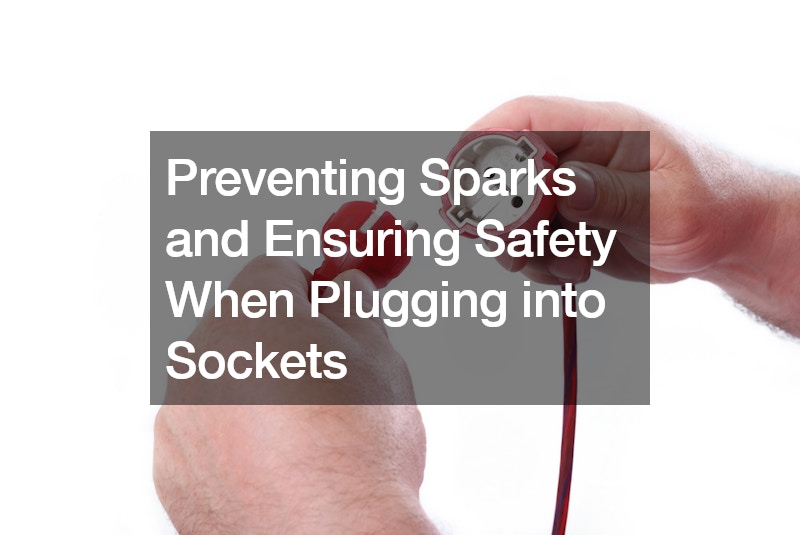
Ensuring electrical safety in your home is crucial, and one common concern is the occurrence of sparks when plugging into a socket. This issue can be both alarming and dangerous, potentially leading to fires if not addressed properly. Here, we will discuss the primary causes of sparks when plugging into sockets and provide practical solutions to prevent them. By following these guidelines and considering professional help from Hiring PSC electrical, you can ensure a safer environment in your home.
Causes of Sparks When Plugging into Sockets
1. Dirty or Damaged Plug Pins
One of the primary causes of sparks is dirty or damaged plug pins. Over time, the pins on electrical plugs can become discolored or corroded, leading to poor contact with the socket.
This poor contact can cause arcing, resulting in visible sparks.
Solution: Regularly inspect the pins on your plugs. They should be shiny and clean. If you notice any discoloration, corrosion, or burn marks, it’s time to replace the plug. Keeping your plugs in good condition ensures a solid connection and minimizes the risk of sparks.
2. Worn-Out Sockets
Sockets themselves can also be the culprit. A socket that is old or worn out may not grip the plug pins firmly, leading to a loose connection. This loose connection can result in arcing and sparks.
Solution: To check if your socket is the problem, use a brand-new plug. If sparks still occur when plugging it in, the socket is likely worn out. Instead of attempting to fix the socket yourself, which can be dangerous, consider Hiring PSC electrical to safely replace or repair the socket.
3. Loose Connections
A good electrical connection is essential for safety. If your plug fits loosely in the socket, it can cause intermittent contact, leading to sparks. This is often due to weakened springs within the socket that no longer provide a tight grip on the plug pins.
Solution: Ensure that your plugs fit tightly into the sockets. If a plug feels loose, it’s a sign that the socket’s springs are no longer effective. Replacing the socket with a new one is the best course of action to maintain a secure connection.
4. Damaged Components
Over time, both plugs and sockets can suffer wear and tear. Plugs can become damaged from frequent use, and sockets can degrade from exposure to electrical currents. Damaged components increase the risk of sparks and should be addressed promptly.
Solution: Regularly inspect both plugs and sockets for signs of damage. Look for any cracks, burn marks, or other visible damage. If you find any issues, replace the damaged components immediately. Hiring PSC electrical can ensure that the replacement is done correctly and safely.
Steps to Ensure Electrical Safety
1. Regular Inspections
Regularly inspect your electrical components, including plugs, sockets, and extension cords. Look for signs of wear and tear, and address any issues immediately. This proactive approach can prevent small problems from becoming major safety hazards.
2. Use Quality Components
Invest in high-quality electrical components. Cheap or low-quality plugs and sockets are more likely to degrade quickly and pose a safety risk. High-quality components are built to last and provide a more secure connection.
3. Proper Installation
Proper installation is crucial for electrical safety. Whether you are replacing a socket or installing a new plug, ensure that the installation is done correctly. Incorrect installation can lead to poor connections and increased risk of sparks.
4. Avoid Overloading Circuits
Overloading circuits can cause excessive wear on sockets and plugs, increasing the risk of sparks. Be mindful of the load on each circuit and avoid using too many high-power devices on a single socket.
5. Professional Assistance
For any electrical issues that you are not confident in handling yourself, seek professional assistance. Hiring PSC electrical can provide you with the expertise needed to address any electrical problems safely and effectively. They can perform thorough inspections, replace damaged components, and ensure that your electrical system is safe and reliable.
The Importance of Addressing Sparks
Ignoring sparks when plugging into a socket is not an option. Sparks are a clear sign of electrical issues that can escalate into more serious problems, including electrical fires. By addressing the root causes of sparks and ensuring that your electrical components are in good condition, you can significantly reduce the risk of fire and other hazards.
In addition to personal inspections and maintenance, professional help from Hiring PSC electrical can provide an added layer of safety. Professional electricians have the knowledge and tools to identify and fix issues that may not be immediately apparent to the untrained eye.
Conclusion
Preventing sparks and ensuring safety when plugging into sockets is a vital aspect of home maintenance. By understanding the common causes of sparks and taking proactive steps to address them, you can protect your home and loved ones from potential electrical hazards. Regular inspections, using quality components, proper installation, avoiding circuit overloads, and seeking professional help when needed are all key strategies in maintaining a safe electrical system. Remember, safety first—never ignore sparks, and always address electrical issues promptly to prevent accidents and ensure peace of mind.
.

